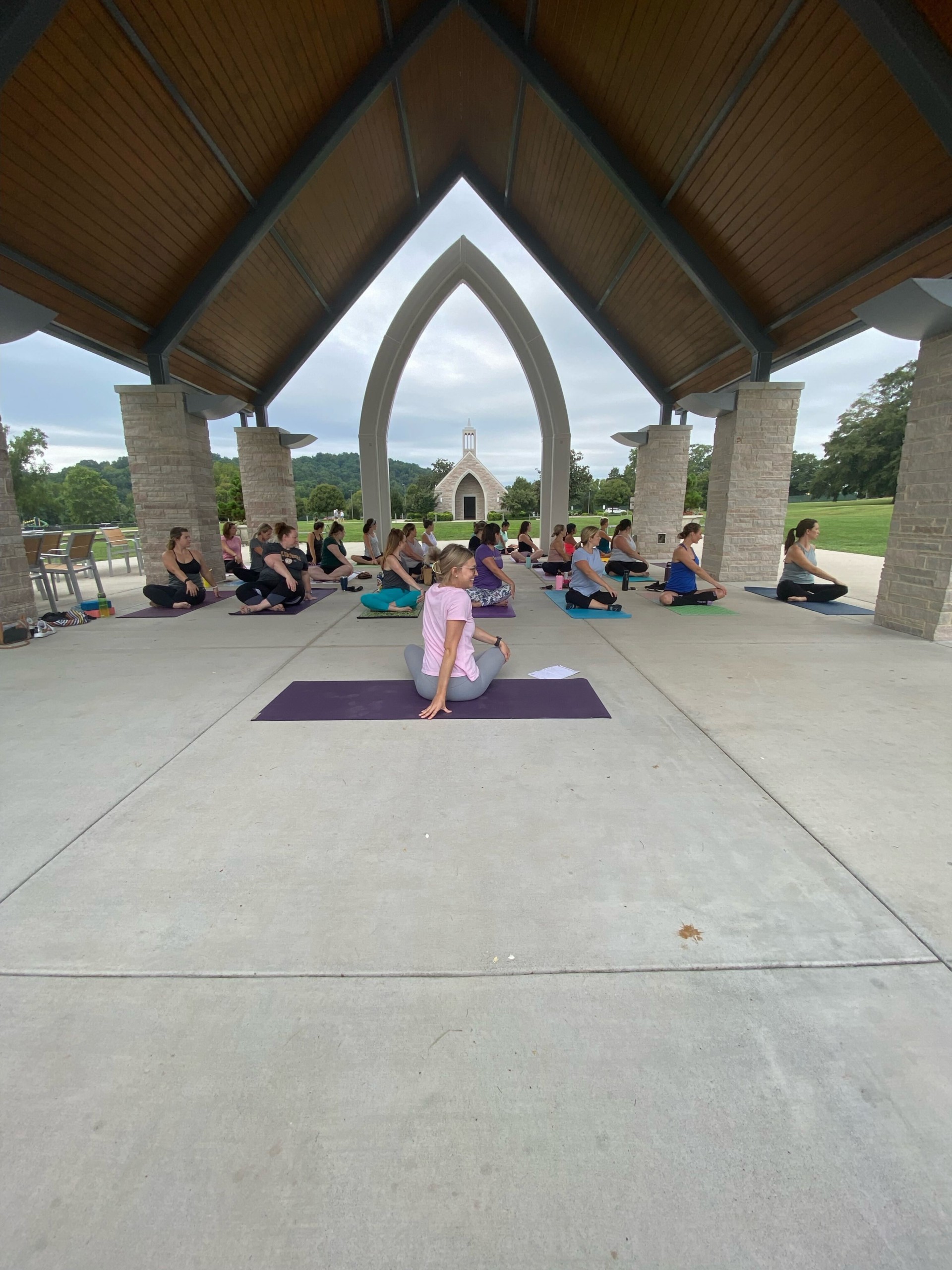Jordan Morgan wrote today’s post on the benefits of doing yoga after 50. Enjoy, darlings!
As women age, their bodies and minds go through many changes. Yoga is especially beneficial for older adults as they navigate the challenges of ageing. For many women over the age of 50, these changes can be challenging and can lead to feelings of loss, insecurity, and isolation. However, yoga can provide a supportive and nourishing practice that can help women to navigate these changes and to maintain their physical and mental well-being. The health benefits of yoga for older adults include improved balance, reduced anxiety, and enhanced overall well-being.

Yoga
Yoga is much more than just a form of physical activity—it’s a holistic practice that nurtures the body, mind, and spirit. As women age, their bodies naturally experience changes such as hormonal shifts, menopausal symptoms, and a gradual decrease in muscle mass. Practicing yoga regularly can be a gentle yet powerful way to address these changes and support overall health. In a typical yoga class, you’ll be guided through a variety of yoga poses, breathing techniques, and meditation practices, all designed to enhance flexibility, strength, and relaxation. A skilled yoga instructor will help you find proper alignment in each pose and offer modifications to suit your unique needs, ensuring your practice is both safe and effective. Whether you’re stepping onto the yoga mat for the first time or returning after a break, yoga offers a welcoming space to reconnect with your body and cultivate well-being at any age.
Here are a few reasons why women over the age of 50 should consider incorporating yoga into their lives.
It can improve physical health:
As women age, their bodies go through many changes, including decreased muscle mass, decreased bone density, and increased risk of chronic conditions such as arthritis and osteoporosis. Yoga can help to counteract these changes and can improve physical health in several ways. In addition to helping prevent muscle loss, yoga helps maintain muscle strength and joint health. After menopause, bone density often declines, but yoga can strengthen bones and support joint health, reducing the risk of osteoporosis.
It can improve flexibility, strength, and balance, which can help to prevent injuries and falls. Yoga also enhances flexibility, improves spinal flexibility, and leads to improved balance, all of which are especially important for women over 50. Practicing yoga is a form of exercise that supports overall fitness, helps maintain healthy body weight, and strengthens muscles. Additionally, yoga can help manage blood pressure, supporting cardiovascular health and stress reduction. It can also improve cardiovascular health and increase lung capacity, which can support overall health and well-being.
Some specific yoga poses are particularly beneficial for women over 50. The Cat-Cow pose (cat cow and cow pose) is performed from a standing position or on hands and knees, with feet hip width apart or hip-width apart for stability. This pose enhances spinal flexibility and relieves tension. Tree Pose (tree pose) is a balancing posture that starts from a standing position with feet hip width apart; shift your weight onto one leg, pull your belly button in for core engagement, and place the other foot on your inner thigh or calf, then switch sides to ensure balanced benefits. Chair Pose uses your body weight to strengthen muscles and bones—stand with feet hip width apart, bend your knees to a right angle, and keep your belly button drawn in. These poses help improve muscle strength, balance, and joint health.
If you are new to yoga, it is important to gradually increase the intensity and duration of your practice to safely build strength, flexibility, and balance.
It can reduce stress and anxiety:
The changes that women experience as they age can be stressful and can lead to feelings of anxiety and uncertainty. Yoga can provide a safe and supportive space to reduce stress and anxiety and can help women to feel more grounded and centered. The breathing and relaxation techniques that are used in yoga can be particularly helpful for reducing stress and anxiety and can help women to feel calmer and more relaxed. These techniques trigger the relaxation response, a physiological state that helps lower blood pressure, alleviate stress, and improve overall well-being. During yoga, remember to take deep breaths and breathe deeply to enhance relaxation and maximize the calming effects of your practice.
It can improve mood and well-being:
As women age, they may experience hormonal changes and other physical changes that can affect their mood and well-being. Yoga can help to improve mood and well-being by providing a sense of accomplishment and connection. The physical practices of yoga can release endorphins and other neurotransmitters that can improve mood and overall well-being, and the social aspect of a yoga practice can provide valuable support and connection.
Additionally, yoga supports cognitive function by helping to maintain mental sharpness, enhance memory, and improve attention, which is especially important for women over 50. Practicing yoga can also help boost energy levels and reduce fatigue, promoting greater vitality and resilience in daily life.
It can support healthy aging:
As women age, they may experience a loss of vitality and a sense of disconnection from their bodies and their lives. Yoga can help to support healthy aging by providing a practice that is tailored to the needs and abilities of older women. Many yoga classes and studios offer gentle and adaptive yoga classes that are specifically designed for women over the age of 50, and these classes can provide a safe and supportive environment for women to explore their physical and emotional selves. In addition to adaptive yoga, other forms of yoga such as chair yoga or restorative yoga are available, offering diverse options to suit different preferences and needs. Using props like mats, blocks, and bolsters can provide extra support during yoga practice, enhancing stability, comfort, and safety, especially for those with joint or balance concerns. A recent meta analysis of randomized controlled trials has shown that yoga offers significant benefits for women over 50, including improvements in bone health, sleep quality, and mental well-being.
Managing Menopausal Symptoms
Navigating menopause can be challenging, with symptoms like hot flashes, mood swings, and disrupted sleep often affecting daily life. Fortunately, practicing yoga regularly can be a valuable tool for managing these menopausal symptoms. Certain yoga poses, such as child’s pose and legs up the wall, are especially effective for calming the nervous system and reducing stress levels. These gentle postures, combined with mindful breathing, can help balance hormones, ease mood swings, and promote better sleep quality. By making yoga a consistent part of your routine, you may notice improvements in your overall quality of life, including a greater sense of balance and emotional well-being. Remember, working with a knowledgeable yoga instructor ensures you receive the right modifications and support, making your practice both comfortable and beneficial as you move through this stage of life.
Tips for Beginners
Start slowly and gently:
Yoga is a lifelong practice, and it is important to start slowly and gently. This means choosing classes and teachers that are appropriate for your level of ability and taking time to warm up and get accustomed to the postures and movements. It is also important to listen to your body and respect your limits.
Use props and modifications:
Yoga can be adapted to suit a wide range of abilities, and it is important to use props and modifications to make the practice comfortable and accessible. This may mean using a chair for balance, using a strap to reach your feet, or using blocks or blankets to support your body. Don’t be afraid to ask for help or to modify the postures to suit your needs.
Focus on your breath:
The breath is an essential part of the yoga practice, and it is important to focus on your breath and to use it to guide your movements. This means inhaling and exhaling deeply and smoothly and using the breath to connect your body and your mind.
Be patient and persistent:
The benefits of yoga are cumulative, and it takes time and practice to see and feel the effects. Be patient with yourself and with your practice, and remember that progress is not linear. It is also important to be persistent and to keep coming back to your practice, even on days when you don’t feel like it.
Find a supportive community:
Yoga can be a solitary practice, but it can also be a communal practice. Many yoga studios and classes offer a supportive and inclusive environment for beginners, and being part of a community can provide valuable support and connection.
Explore different styles and teachers:
There are many different styles, and it is important to explore and find the style and teacher that resonates with you. This may mean trying different classes and teachers and experimenting with different styles and approaches.
Take care of your body:
Yoga is a physical practice, and it is important to take care of your body before, during, and after your practice. This means warming up and cooling down, staying hydrated, and listening to your body. It also means avoiding overdoing it and respecting your limits.
Be open and curious:
Yoga is a practice of self-discovery, and it is important to approach your practice with an open and curious mind. This means being open to new experiences and new ways of being.
Advanced Yoga Practices
As your confidence and experience with yoga grow, you might feel inspired to explore advanced yoga practices that offer even deeper benefits. Styles such as yin yoga, restorative yoga, and yoga nidra each bring something unique to your yoga practice. Yin yoga involves holding poses for longer periods, allowing you to target the connective tissues and enhance flexibility. Restorative yoga uses props to fully support the body in restful poses, encouraging profound relaxation and stress relief. Yoga nidra, often called yogic sleep, is a guided meditation practice that leads you into a state of deep relaxation, helping to reduce stress and restore energy. Incorporating these advanced practices into your routine can elevate your yoga experience, supporting your body, mind, and spirit as you continue to age gracefully and stay healthy.
In conclusion
Yoga can provide many benefits for women over the age of 50. Whether you are looking to improve your physical health, reduce stress and anxiety, improve your mood, or support healthy aging, yoga can provide a nourishing and supportive practice that can help you to navigate the challenges and changes of aging. By incorporating yoga into your daily routine, you can improve your physical health, reduce stress and anxiety, and cultivate a positive and accepting relationship with your body and your life.
Have you ever tried yoga darling? I think I need to give it another shot! Tell us in the comments about your favorite way to access after 50!

About the author:
Jordan Morgan is a freelance writer and yoga teacher passionate about motherhood, mental health, and helping women find a community so they don’t feel so alone.
** Please note that items purchased through links on this site may result in a commission for Honey Good.
+ show Comments
- Hide Comments
add a comment